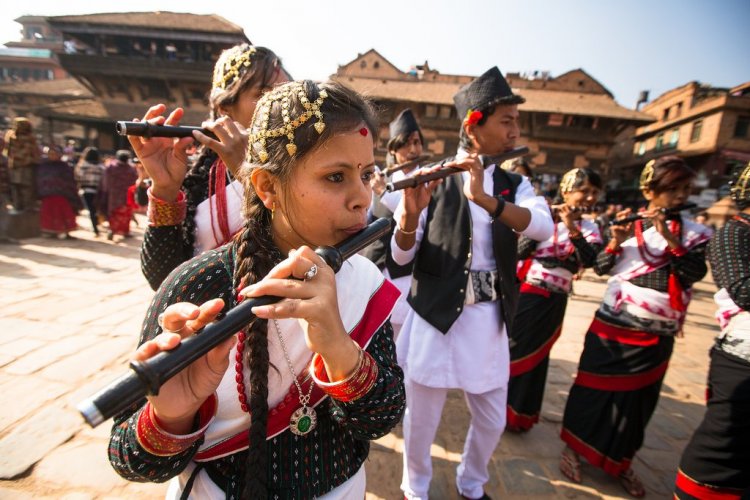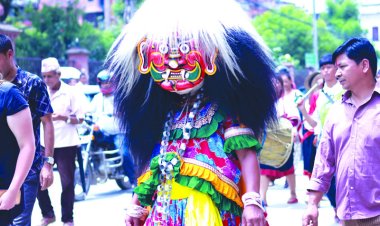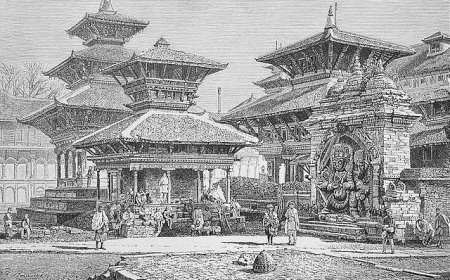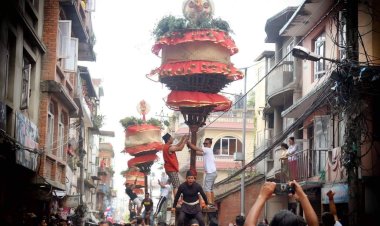History of the Newari Community
About Newari Community

The Newar people are the historical inhabitants of the Kathmandu Valley and its surroundings in Nepal and the founders of its historical civilization. The valley and surrounding areas were formed by the former Mandala Newar Kingdom of Nepal. Unlike an ethnic group of common descent, the Newars are a good example of a national community with a relict identity. Within the Newari community it consists of various types of racial, caste and religious heterogeneity, as today's Newars are descendants of a diverse group of people who lived in Nepal. Indo-Aryan settlers like Licchavis and Mallas who came at different times gradually mixed with the local Newar aboriginal community by adopting their language and customs. These immigrants retained their Indian heritage and brought with them their Sanskritic languages, social structure, Vedic religion and culture, which profoundly changed the history of Newar civilization. Newar rule in Nepal Mandala ended in 1768 when it was conquered by the Gorkha kingdom. Agriculture is the main occupation in Nepal, some have recently become involved in tourism-related businesses and some other occupations. They lived in these areas for several years. The preservation of their culture through a house and museum of culture was a very important topic there. They are considered to be brave and hardy men as they are the only group in Nepal Hill who have lived successfully.
The Newar maintain a highly literate community and its members are influential in all fields, from agriculture, industry, education and government to medicine, law, religion, architecture, fine arts and literature. It is generally accepted that Newar architects may have been responsible for designing Asian multi-tiered pagoda architecture. Newar devotional painting, sculpture and metalwork Paubha and thangka are known worldwide for their exquisite beauty. The beautiful temples and palaces of Kathmandu, Patan (Yala) and Bhaktapur are mainly the work of Newar architects, craftsmen and sculptors. Now enterprising Newars are scattered across Nepal, Bhutan, Sikkim state and Darjeeling district in India. The Newar, a people who make up about half the population of Kathmandu Valley in Nepal, speak a language belonging to the Tibeto-Burman family, but their culture has been heavily influenced by Indian religious and social institutions. The Newar population in Nepal was estimated at just over a million in the early 2000s. Most Newars are Hindu, but some practice the Indian form of Buddhism. There are about 70 castes, both Buddhist and Hindu, covering about the same spectrum as India's caste system. The Newar have a wide variety of occupations, many are farmers, others are prominent in retail trade, and some hold high political and administrative positions. They were traditionally known as architects and craftsmen, builders of the famous temples and shrines of Kathmandu. From the 10th to the 16th century, painting and sculpture flourished in Newar, along with crafts such as pottery, papermaking, carving, and metallurgy. Each of the crafts is traditionally a specialty of a certain caste.
People
The Newar is one of the 59 indigenous peoples recognized by the government of Nepal. Newars are found in every part of the country and beyond, but they are the original inhabitants of the Kathmandu Valley, the capital of modern Nepal. Earlier, the Kathmandu Valley was known as "Nepal" and for many people, the words "Nepal" still mean it. As early as the 7th century BC, the Nepalese valley was inhabited by Tibeto-Burman speaking Mongoloids, who later founded the Kirat dynasty. In the second century AD, Kirat rule was replaced by the Lichhavas of northern Bihar, who spoke Prakit but used Sanskrit for sacramental purposes. The Newar are also said to be descended from the Kirat people who bordered the land in the past.
The Newar speak their mother tongue, which belongs to the Tibeto-Burman language family, with a rich ancient and modern literature dating back to the 14th century. During the Malla period, from the 13th century until his fall in 1769 AD, the kings of the day themselves played a significant role in the promotion of Newar literature. The Newars include people of both Mongoloid and Caucasian extraction. They practice both Hinduism and Buddhism. They have their own distinct culture with a long history that is heavily influenced by both Buddhism and Hinduism with remnants of the ancient Kirat culture. They have different way of life, customs and traditions of Newar. They are very famous for their skills in carving, painting, stone carving. The Newars are one of the few indigenous nationalities that have been urban oriented and have achieved great success in politics, bureaucracy, art and architecture.
Food
Food is a very important part of Newars ritual and religious life. Dishes served to guests at celebrations and banquets have their symbolic meaning. Different sets of ritual dishes are placed in a circle around the basic rice flakes to represent and honor different sets of deities (gods) depending on the festival or ceremony.
The meal consists of rice (JA), dal (KE) and vegetables (tarkari). They eat the same food in the morning and in the evening. If one can afford it, meat(la) item is seen on the side of a regular Newar meal.
Newars prefer to eat snacks in the afternoon. It usually consists of flat rice (baji), eaten with such items as roasted and curried soybeans (musya), fermented mustard leaves (gundro) or curry potatoes (alu tarakari). They also have some meat (la) and homemade liquor (thon) with them. Baji (rice flakes) is called chiura in Nepali. Another major category of food is served at feasts. In this dish, the main dish is beaten rice (baji). At banquets, various preparations based on buffalo meat are served together with vegetable and legume curries. Homemade liquor (thon) is served with the meal. Generally, the feast meal ends with the serving of curd, sugar and fruit (sisapusa). Betel nut pieces, fennel seeds and cloves are usually served as dessert at the end of the meal. Kwati (various bean soup), Kachila (spiced minced meat), Choila, which is water buffalo meat marinated in spices and grilled over the flames of dried wheat stalks, wo (lentil cake), paun kwa (sour soup), stuffed lungs, fried liver, fried tongue, tripe stuffed with bone marrow and jelly fish soup are some of the popular festival dishes. Dessert consists of dhau (yogurt), sisabusa (fruit) and mari (sweet meat). Thwon and aila are common alcoholic liquors that Newars make at home.
At meals, festivals and gatherings, Newars sit on long mats in rows. Typically, the seating arrangement is hierarchical, with the oldest sitting at the top and the youngest at the end. Newari cuisine uses mustard oil and a variety of spices such as cumin, sesame seeds, turmeric, garlic, ginger, mint, bay leaves, cloves, cinnamon, pepper, chilies and mustard seeds.
Local community
The creators of all these impressive cultural heritages, the Newars are the locals living in and around the Kathmandu Valley. According to the 2011 census, the Newari population constitutes approximately 6 percent of the total population and is also the sixth most populous ethnic group in Nepal. They are mainly found in the Bagmati region of Kathmandu, Bhaktapur and Lalitpur, but are spread in mere numbers around the world.
The Newars are a traditional caste of merchants and traders who are prominent in the ancient urban areas of Nepal, including Kathmandu. Before the "unification of Nepal", Newari kingdoms existed along the main trade routes in the Nepalese hills, and the Newari kings were renowned for their temples and crafts. Many of Kathmandu's old palaces and temples are the work of the Newars, and their rich woodcarving and stonework practices continue to this day. Newars make up less than 6 percent of the population and speak Newari, a peculiar and difficult to learn Tibetan Barman language.
Jatra, the term refers to the Newari community of Nepal celebrating festivals. The historical inhabitants of the Kathmandu Valley are the Newar or Newah, the founders of the ancient heritage and culture. They are known for their rich history, significant cultural diversity and urban life. This culture includes many festivals known as Jatras. There are many ceremonies and gatherings in Newari culture including birthday parties, rice feeding.
What's Your Reaction?




































































































